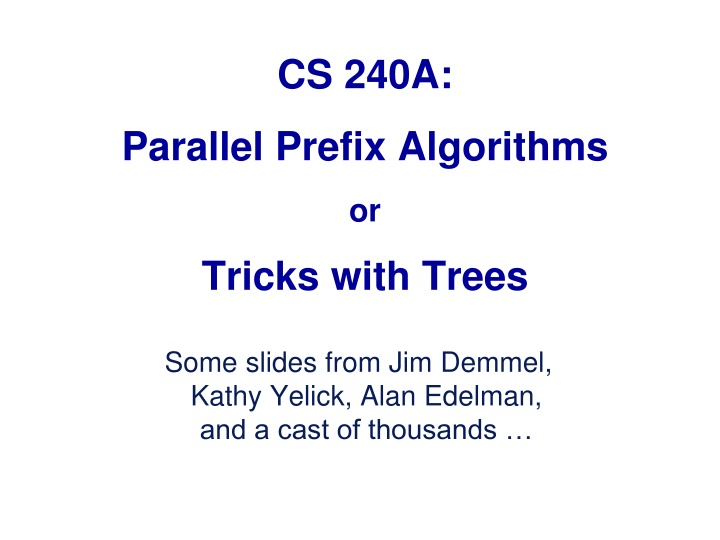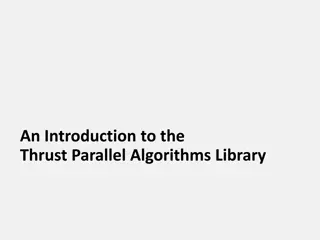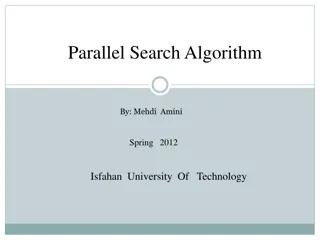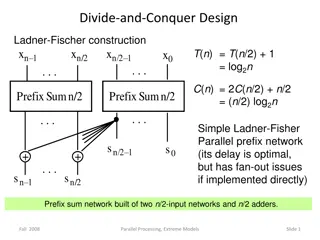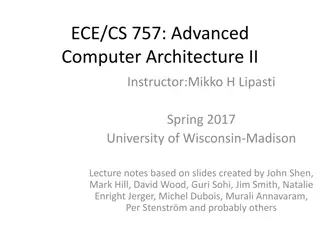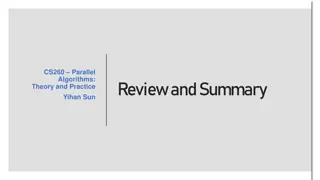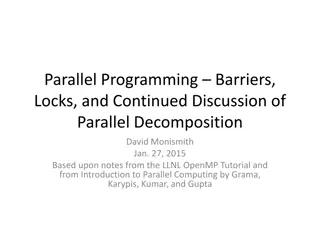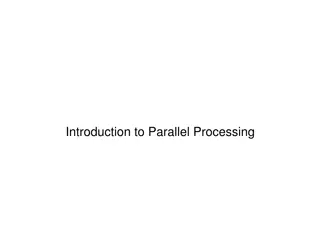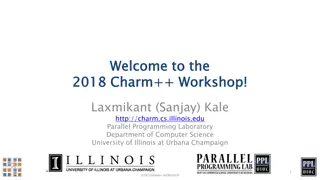Parallel Prefix Algorithms and PRAM Model: A Theoretical Approach
Explore parallel prefix algorithms and the PRAM model of parallel computation in the context of turning serial processes into parallel ones. Understand the concepts of vector operations, broadcast, reduction, and examples of prefix functions. Delve into theoretical insights and practical applications in parallel computation.
Download Presentation

Please find below an Image/Link to download the presentation.
The content on the website is provided AS IS for your information and personal use only. It may not be sold, licensed, or shared on other websites without obtaining consent from the author.If you encounter any issues during the download, it is possible that the publisher has removed the file from their server.
You are allowed to download the files provided on this website for personal or commercial use, subject to the condition that they are used lawfully. All files are the property of their respective owners.
The content on the website is provided AS IS for your information and personal use only. It may not be sold, licensed, or shared on other websites without obtaining consent from the author.
E N D
Presentation Transcript
CS 240A: Parallel Prefix Algorithms or Tricks with Trees Some slides from Jim Demmel, Kathy Yelick, Alan Edelman, and a cast of thousands
PRAM model of parallel computation . . . P2 P1 Pn Parallel Random Access Machine Memory Very simple theoretical model, used in 1970s and 1980s for lots of paper designs of parallel algorithms. Processors have unit-time access to any location in shared memory. Number of processors is allowed to grow with problem size. Goal is (usually) an algorithm with span O(log n) or O(log2n). Eg: Can you sort n numbers with T1= O(n log n) and Tn= O(log n)? Was a big open question until Cole solved it in 1988. Very unrealistic model but sometimes useful for thinking about a problem.
Parallel Vector Operations Vector add: z = x + y Embarrassingly parallel if vectors are aligned; span = 1 DAXPY: v = *v + *w (vectors v, w; scalar , ) Broadcast & , then pointwise vector +; span = log n DDOT: = vT*w (vectors v, w; scalar ) Pointwise vector *, then sum reduction; span = log n
Broadcast and reduction Broadcast of 1 value to p processors with log p span Broadcast Reduction of p values to 1 with log p span Uses associativity of +, *, min, max, etc. 1 3 1 0 4 -6 3 2 Add-reduction
Parallel Prefix Algorithms A theoretical secret for turning serial into parallel Surprising parallel algorithms: If there is no way to parallelize this algorithm! it s probably a variation on parallel prefix!
Example of a prefix (also called a scan) Sum Prefix Input Output yi = j=1:i xj Example x = ( 1, 2, 3, 4, 5, 6, 7, 8 ) y = ( 1, 3, 6, 10, 15, 21, 28, 36) x = (x1, x2, . . ., xn) y = (y1, y2, . . ., yn) Prefix functions-- outputs depend upon an initial string
What do you think? Can we really parallelize this? It looks like this kind of code: y(0) = 0; for i = 1:n y(i) = y(i-1) + x(i); The ith iteration of the loop depends completely on the (i-1)st iteration. Work = n, span = n, parallelism = 1. Impossible to parallelize, right?
A clue? x = ( 1, 2, 3, 4, 5, 6, 7, 8 ) y = ( 1, 3, 6, 10, 15, 21, 28, 36) Is there any value in adding, say, 4+5+6+7? If we separately have 1+2+3, what can we do? Suppose we added 1+2, 3+4, etc. pairwise -- what could we do?
Prefix sum in parallel Algorithm: 1. Pairwise sum 2. Recursive prefix 3. Pairwise sum 1 2 3 4 5 6 7 8 9 10 11 12 13 14 15 16 3 7 11 15 19 23 27 31 (Recursively compute prefix sums) 3 10 21 36 55 78 105 136 1 3 6 10 15 21 28 36 45 55 66 78 91 105 120 136 9
Parallel prefix cost: Work and Span What s the total work? 1 2 3 4 5 6 7 8 Pairwise sums 3 7 11 15 Recursive prefix 3 10 21 36 Update odds 1 3 6 10 15 21 28 36 T1(n) = n/2 + n/2 + T1 (n/2) = n + T1 (n/2) = 2n 1 10 at the cost of more work!
Parallel prefix cost: Work and Span What s the total work? 1 2 3 4 5 6 7 8 Pairwise sums 3 7 11 15 Recursive prefix 3 10 21 36 Update odds 1 3 6 10 15 21 28 36 T1(n) = n/2 + n/2 + T1 (n/2) = n + T1 (n/2) = 2n 1 11 Parallelism at the cost of more work!
Parallel prefix cost: Work and Span What s the total work? 1 2 3 4 5 6 7 8 Pairwise sums 3 7 11 15 Recursive prefix 3 10 21 36 Update odds 1 3 6 10 15 21 28 36 T1(n) = n/2 + n/2 + T1 (n/2) = n + T1 (n/2) = 2n 1 T (n) = 2 log n Parallelism at the cost of twice the work! 12
Non-recursive view of parallel prefix scan Tree summation: two phases up sweep get values L and R from left and right child save L in local variable Mine compute Tmp = L + R and pass to parent down sweep get value Tmp from parent send Tmp to left child send Tmp+Mine to right child Up sweep: Down sweep: mine = left tmp = parent (root is 0) 0 6 6 tmp = left + right 4 5 right = tmp + mine 6 9 0 6 4 6 11 4 5 3 2 4 1 4 5 4 0 3 4 6 6 1011 12 3 2 4 1 +X = 3 1 2 0 4 1 1 3 3 4 6 6 10 11 12 15 3 1 2 0 4 1 1 3 13
Any associative operation works Associative: (a b) c = a (b c) Sum (+) All (and) Product (*) Any ( or) MatMul Max Input: Matrices Min Input: Bits (Booleans) (not commutative!) Input: Reals
Scan (Parallel Prefix) Operations Definition: the parallel prefix operation takes a binary associative operator , and an array of n elements [a0, a1, a2, an-1] and produces the array [a0, (a0 a1), (a0 a1 ... an-1)] Example: add scan of [1, 2, 0, 4, 2, 1, 1, 3] is [1, 3, 3, 7, 9, 10, 11, 14] 15
Applications of scans Many applications, some more obvious than others lexically compare strings of characters add multi-precision numbers add binary numbers fast in hardware graph algorithms evaluate polynomials implement bucket sort, radix sort, and even quicksort solve tridiagonal linear systems solve recurrence relations dynamically allocate processors search for regular expression (grep) image processing primitives 16
Using Scans for Array Compression Given an array of n elements [a0, a1, a2, an-1] and an array of flags [1,0,1,1,0,0,1, ] compress the flagged elements into [a0, a2, a3, a6, ] Compute an add scan of [0, flags] : [0,1,1,2,3,3,4, ] Gives the index of the ith element in the compressed array If the flag for this element is 1, write it into the result array at the given position 17
Array compression: Keep only positives Matlab code % Start with a vector of n random #s % normally distributed around 0. A = randn(1,n); flag = (A > 0); addscan = cumsum(flag); parfor i = 1:n if flag(i) B(addscan(i)) = A(i); end; end; 18
Fibonacci via Matrix Multiply Prefix Fn+1 = Fn + Fn-1 F F 1 1 + n 1 n = F F 1 0 n 1 - n Can compute all Fn by matmul_prefix on [ , , , , , , , , ] then select the upper left entry 1 1 1 1 1 1 1 1 1 1 1 1 1 1 1 1 1 1 1 0 1 0 1 0 1 0 1 0 1 0 1 0 1 0 1 0 19
Carry-Look Ahead Addition (Babbage 1800 s) Example 1 0 1 1 1 1 0 1 1 1 First Int 1 0 1 0 1 Second Int 1 0 1 1 0 0 Sum Carry Goal: Add Two n-bit Integers
Carry-Look Ahead Addition (Babbage 1800 s) Goal: Add Two n-bit Integers ExampleNotation 1 0 1 1 1 Carry 1 0 1 1 1 First Int 1 0 1 0 1 Second Int 1 0 1 1 0 0 Sum c2 c1 c0 a3 a2 a1 a0 b3 b2 b1 b0 s3 s2 s1 s0
Carry-Look Ahead Addition (Babbage 1800 s) Goal: Add Two n-bit Integers ExampleNotation 1 0 1 1 1 Carry 1 0 1 1 1 First Int 1 0 1 0 1 Second Int 1 0 1 1 0 0 Sum c2 c1 c0 a3 a2 a1 a0 b3 b2 b1 b0 s3 s2 s1 s0 c-1 = 0 for i = 0 : n-1 (addition mod 2) si = ai + bi + ci-1 ci = aibi + ci-1(ai + bi) end sn = cn-1
Carry-Look Ahead Addition (Babbage 18) Goal: Add Two n-bit Integers ExampleNotation 1 0 1 1 1 Carry 1 0 1 1 1 First Int 1 0 1 0 1 Second Int 1 0 1 1 0 0 Sum c-1 = 0 for i = 0 : n-1 c2 c1 c0 a3 a2 a1 a0 b3 b2 b1 b0 s3 s2 s1 s0 ci 1 ai + bi aibi ci-1 0 1 1 si = ai + bi + ci-1 ci = aibi + ci-1(ai + bi) end = (addition mod 2) sn = cn-1
Carry-Look Ahead Addition (Babbage 1s) Goal: Add Two n-bit Integers ExampleNotation 1 0 1 1 1 Carry 1 0 1 1 1 First Int 1 0 1 0 1 Second Int 1 0 1 1 0 0 Sum c2 c1 c0 a3 a2 a1 a0 b3 b2 b1 b0 s3 s2 s1 s0 c-1 = 0 ci 1 ai + bi aibi ci-1 0 1 1 for i = 0 : n-1 = si = ai + bi + ci-1 ci = aibi + ci-1(ai + bi) end 1. compute ci by binary matmul prefix 2. compute si = ai + bi +ci-1 in parallel sn = cn-1
Adding two n-bit integers in O(log n) time Let a = a[n-1]a[n-2] a[0] and b = b[n-1]b[n-2] b[0] be two n-bit binary numbers We want their sum s = a+b = s[n]s[n-1] s[0] c[-1] = 0 rightmost carry bit for i = 0 to n-1 c[i] = ( (a[i] xor b[i]) and c[i-1] ) or ( a[i] and b[i] ) ... next carry bit s[i] = a[i] xor b[i] xor c[i-1] Challenge: compute all c[i] in O(log n) time via parallel prefix for all (0 <= i <= n-1) p[i] = a[i] xor b[i] propagate bit for all (0 <= i <= n-1) g[i] = a[i] and b[i] generate bit c[i] = ( p[i] and c[i-1] ) or g[i] = p[i] g[i] * c[i-1] = M[i] * c[i-1] 1 1 0 1 1 1 2-by-2 Boolean matrix multiplication (associative) = M[i] * M[i-1] * M[0] * 0 1 evaluate each product M[i] * M[i-1] * * M[0] by parallel prefix Used in all computers to implement addition - Carry look-ahead 25
Segmented Operations Inputs = ordered pairs (operand, boolean) e.g. (x, T) or (x, F) Change of segment indicated by switching T/F 2 (y, T) (x y, T) (y, F) (x, T) (y, F) (x y, F) (x, F) (y, T) e. g. 1 2 3 4 5 6 7 8 T T F F F T F T Result 1 3 3 7 12 6 7 8 26
Any Prefix Operation May Be Segmented!
Graph algorithms by segmented scans 0 1 nbr: 1 2 0 2 3 3 2 flag: T T F F F T F 2 3 firstnbr: 0 2 5 6 7 The usual CSR data structure, plus segment flags!
Multiplying n-by-n matrices in O(log n) span For all (1 <= i,j,k <= n) P(i,j,k) = A(i,k) * B(k,j) span = 1, work = n3 For all (1 <= i,j <= n) C(i,j) = P(i,j,k) span = O(log n), work = n3 using a tree 29
Inverting dense n-by-n matrices in O(log2 n) span Lemma 1: Cayley-Hamilton Theorem expression for A-1 via characteristic polynomial in A Lemma 2: Newton s Identities Triangular system of equations for coefficients of characteristic polynomial Lemma 3: trace(Ak) = Ak [i,i] = [ i (A)]k Csanky s Algorithm (1976) 1) Compute the powers A2, A3, ,An-1 by parallel prefix span = O(log2 n) 2) Compute the traces sk = trace(Ak) span = O(log n) 3) Solve Newton identities for coefficients of characteristic polynomial span = O(log2 n) 4) Evaluate A-1 using Cayley-Hamilton Theorem span = O(log n) n n i=1 i=1 Completely numerically unstable 30
Evaluating arbitrary expressions Let E be an arbitrary expression formed from +, -, *, /, parentheses, and n variables, where each appearance of each variable is counted separately Can think of E as arbitrary expression tree with n leaves (the variables) and internal nodes labelled by +, -, * and / Theorem (Brent): E can be evaluated with O(log n) span, if we reorganize it using laws of commutativity, associativity and distributivity Sketch of (modern) proof: evaluate expression tree E greedily by collapsing all leaves into their parents at each time step evaluating all chains in E with parallel prefix 31
The myth of log n The log2 n span is not the main reason for the usefulness of parallel prefix. Say n = 1000000p (1000000 summands per processor) Cost = (2000000 adds) + (log2P message passings) fast & embarassingly parallel (2000000 local adds are serial for each processor, of course) 32
Summary of tree algorithms Lots of problems can be done quickly - in theory - using trees Some algorithms are widely used broadcasts, reductions, parallel prefix carry look ahead addition Some are of theoretical interest only Csanky s method for matrix inversion Solving tridiagonal linear systems (without pivoting) Both numerically unstable Csanky does too much work Embedded in various systems CM-5 hardware control network MPI, UPC, Titanium, NESL, other languages 33
